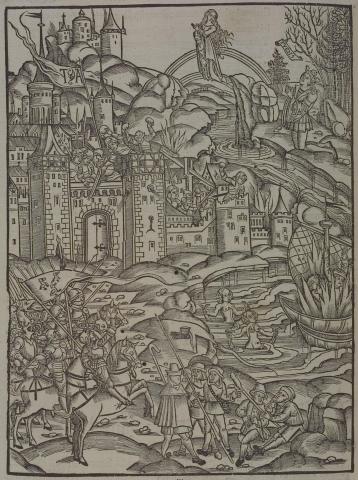Annotations
In the upper right, Iris, signified by her double rainbow, speaks to Turnus, urging him to attack Aeneas's camp in Latium while Aeneas is away (1-13). In this image, she appears to have nearly completed her speech, and is turning to fly away (14-5). Turnus, recognizing the presence of a goddess, raises his hands, clasped in the Christian way rather than upturned in the pagan tradition, and vows to do as she says (16-22). He is shown already by the river where he goes to solemnize his vows (22-4). In the lower left, Turnus's army, commanded by Turnus and Messapus advance proudly across the plain toward the Trojan camp (25-34) under a standard of three birds. The sons of Tyrrhus, who are supposed to be commanding the rear of the army (27-8), are shown standing and seated near Messapus, unlabeled but distinguished by the shepherd's staff held by one and the club held by another. Since the Teucrians have locked themselves within the strong walls of their camp and at first refuse to engage in conflict (35-57), Turnus sets fire to the ships, on the right (69-76). Once the fire has touched the ships, they turn into sea goddesses in maiden form, here shown as mermaids, because the trees used to build the ships were sacred to Cybele (77-122).
Woodcut illustration from the “Strasbourg Vergil,” edited by Sebastian Brant: Publii Virgilii Maronis Opera cum quinque vulgatis commentariis expolitissimisque figuris atque imaginibus nuper per Sebastianum Brant superadditis (Strasbourg: Johannis Grieninger, 1502), fol. 329v, executed by an anonymous engraver under the direction of Brant.


Sebastian Brant (1458-1521) was a humanist scholar of many competencies. Trained in classics and law at the University of Basel, Brant later lectured in jurisprudence there and practiced law in his native city of Strasbourg. While his satirical poem Das Narrenschiff won him considerable standing as a writer, his role in the transmission of Virgil to the Renaissance was at least as important. In 1502 he and Strasbourg printer Johannes Grüninger produced a major edition of Virgil’s works, along with Donatus’ Life and the commentaries of Servius, Landino, and Calderini, with more than two hundred woodcut illustrations. (Annabel Patterson)